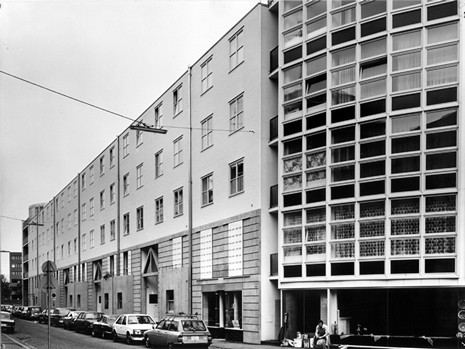Description
The three-winged block-edge development does not connect to the adjacent buildings, thereby creating a passage for an avenue of trees, which precedes the block to the north. The short end sides are occupied by corner maisonettes and are thus articulated by openings that overlook the passage on one side and the city on the other, entirely different than would be the case with a standard compartment wall.
In the north-south facing standard floor plan a, the hallway is characterized by the intersection of two directions, one orthogonal and the other diagonal. The hallways, thus connects entrance and living room, living room and sleeping area and also links bathroom, WC, and kitchen to the center area. In the corner type with central access, the diagonal divides four units, but it also characterizes the larger apartments in a subtle way b. By turning into the diagonal, the dining area expands the living room, and in the other direction it links up with the kitchen and the loggia. The hallway is thus the focal point of a circular internal path.
Drawings
Floor plan diagram, scale 1:500
Site plan
Standard floor plan
3-room apartments type A, scale 1:200
1- and 3-room apartments type B and C, scale 1:200
6-room apartment type D, scale 1:200
Cross section
Photos
 Street façade
Street façade
 Inner courtyard
Inner courtyard
Originally published in: Oliver Heckmann, Friederike Schneider (eds.), Floor Plan Manual Housing, fourth revised and expanded edition, Birkhäuser, 2011.